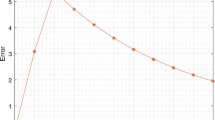Abstract—
Computer simulation of vehicular traffic on the real road network can be used to solve a whole range of relevant and practical problems. The microscopic approach and tens of thousands of vehicles used in simulation lead to large systems of ordinary differential equations. The vehicle dynamics can vary significantly. As a result, the corresponding systems of differential equations have a certain feature, i.e., the rate of change in unknown vector components, which in this case are the speeds of vehicles and the distances (gaps) between them, varies significantly. In this paper, we propose a multirate numerical integration scheme, in which an individual microstep is used for each component of the vector of unknowns within each macrostep. The values of the steps are determined using the obtained local error estimate of the given numerical scheme. The corresponding time-stepping strategy is obtained both for vehicle speeds and for distances between vehicles. Moreover, the multirate solver’s local error for gaps is estimated one order of accuracy higher than for speeds because drivers estimate the gap primarily rather than the speed. The developed numerical method shows a significant computational speedup in comparison with the corresponding single-rate method.


Similar content being viewed by others
REFERENCES
M. Treiber and A. Kesting, Traffic Flow Dynamics (Springer, Berlin, 2013).
A. V. Gasnikov, Introduction to Mathematical Modeling of Traffic Flows (MFTI, Moscow, 2010) [in Russian].
G. Orosz, R. E. Wilson, and B. Krauskopf, “Global bifurcation investigation of an optimal velocity traffic model with driver reaction time,” Phys. Rev. E 70, 026207 (2004).
A. Tordeux, S. Lassarre and M. Roussignol, “An adaptive time gap car-following model,” Transp. Res., Part B 44, 1115–1131 (2010).
C. Gear and D. Wells, “Multirate linear multistep methods,” BIT 24, 484–502 (1984).
M. Gunther, A. Kværnø, and P. Rentrop, “Multirate partitioned Runge-Kutta methods,” BIT 41, 504–514 (2001).
V. Savcenco, W. Hundsdorfer, and J. G. Verwer, “A multirate time stepping strategy for stiff ordinary differential equations,” BIT 47, 137–155 (2007).
A. B. Korchak and A. V. Evdokimov, “The method of parallel calculation of split systems of differential equations with multiple steps,” Tr. MFTI 2 (2), 77–85 (2010).
V. V. Kurtc and I. E. Anufriev, “Multirate numerical scheme for large-scale vehicle traffic simulation,” Math. Models Comput. Simul. 8, 744–751 (2016).
H. J. Payne, “Models of freeway traffic and control,” in Mathematical Models of Public Systems, Ed. by G. A. Bekey (Simulation Council, 1971), Vol. 1, pp. 51–61.
B. S. Kerner and P. Konhauser, “Cluster effect in initially homogeneous traffic flow,” Phys. Rev. E 48, 2335–2338 (1993).
A. A. Chechina, N. G. Churbanova and M. A. Trapeznikova, “Two-dimensional hydrodynamic model for traffic flow simulation using parallel computer systems,” in Proceedings of the International Conference of the Numerical Analysis and Applied Mathematics 2014, AIP Conf. Proc. 1648, 530007 (2015).
R. Jiang, Q. Wu, and Z. Zhu, “Full velocity difference model for a car-following theory,” Phys. Rev. E 64, 017101-1–017101-4 (2001).
M. Treiber, A. Kesting, and D. Helbing, “Delays, inaccuracies and anticipation in microscopic traffic models,” Phys. A (Amsterdam, Neth.) 360, 71–88 (2006).
I. Lubashevsky, P. Wagner, and R. Manhke, “A bounded rational driver model,” Eur. Phys. J. B 32, 243–247 (2003).
A. Kværnø, “Stability of multirate Runge-Kutta schemes,” Int. J. Differ. Equ. Appl. 1A, 97–105 (2000).
S. Skelboe, “Stability properties of backward differentiation multirate formulas,” Appl. Numer. Math. 5, 151–160 (1989).
A. Verhoeven et al., “Stability analysis of the BDF slowest first multirate methods,” CASA-Report No. 0704, Int. J. Comput. Math. 84, 895–923 (2006).
V. Kurtc and I. Anufriev, “Local stability conditions and calibrating procedure for new car-following models used in driving simulators,” in Proceedings of the 10th Conference on Traffic and Granular Flow'13, 2015, pp. 453–461.
Author information
Authors and Affiliations
Corresponding author
Additional information
Translated by O. Pismenov
Rights and permissions
About this article
Cite this article
Kurtc, V.V., Anufriev, I.E. Multirate Solver with Speed and Gap Control. Math Models Comput Simul 11, 386–392 (2019). https://doi.org/10.1134/S207004821903013X
Received:
Published:
Issue Date:
DOI: https://doi.org/10.1134/S207004821903013X




